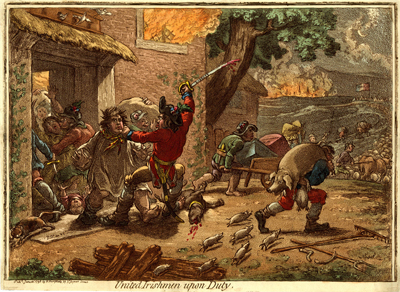United Irishmen upon Duty
This is one of a paired set of prints, along with United Irishmen in Training, published on successive days (June 12 and 13, 1798). Both were prompted by the bloody uprising of the United Irishmen in several counties in Ireland from May 23 until July 14, 1798.

© Trustees of the British Museum
In contrast to its partner, United Irishmen in Training, this print is much darker both literally and figuratively. It is set at night: a crescent moon is partially obscured by a cloudy sky. What illumination there is in the print is coming from two fires. One is blazing from the upstairs window of the house of a loyalist which is now under attack from members of the United Irishmen. The other is coming from what appears to be an entire town on fire just beyond the tents of the rebels with their French tri-color flag. Gillray's extensive use of aquatint gives the whole print a shadowy feeling both ominous and sad.
The peace of this little farmhouse (as suggested by the fleeing doves above the doorway) has been shattered. Farming tools lay broken and scattered in the yard. The family watchdog has been killed, and now the rebel with a bloody sword inscribed "Liberty" is about to kill its master. The mistress of the house is vainly trying to fend off the attentions of another rebel, while her infant is in danger of being trampled at her feet. Other members of the United Irishmen are looting the house, carrying off both property and livestock.*
The Society of United Irishmen was founded by Wolfe Tone and Napper Tandy in 1791. Inspired by the success of the American and French Revolutions, the society was initially aimed at bringing Irish Catholics and Protestants together to limit British involvement in Irish affairs and to lobby for significant parliamentary reform. Over time, however, the Society became more radical, breaking away from the more moderate approaches of Henry Grattan and his followers and advocating the overthrow of British rule in Ireland and enlisting the help of France. When France declared war against Britain in 1793, the Society was outlawed and effectively driven underground. And after the abortive French Invasion of Ireland in December 1796 (planned with the help of the United Irishmen) martial law was declared, habeas corpus suspended, houses searched for weapons, and anyone suspected of rebel sympathies could find themselves arrested and tortured. Atrocities by government forces such as pitch-capping and half-hanging ultimately led to full-scale rebellion which broke out a few weeks before this print appeared.
To provide an idea of what Gillray could have been reading while he worked on this print, here is an extract of a letter from a government soldier in Maryborough published in Bell's Weekly Messenger (June 10, 1798):
An order is just come for us to march to Rath with two field pieces. At this moment there is an engagement at Mountmeleck; and reports confidently assert, that the 4th horse are now retreating. We have not half force enough in these parts. An express is just arrived from Kildare The coach is burned; the coachman, horses, guards, passengers, all murdered by these savage barbarians; and I am sorry to say, one corps of yeomanry [governmental troops] turned coats, and went over to the united villains. Lord Roden's brother was unfortunately a passenger, and cruelly murdered. Many towns and villages are set on fire. Some of these murderers were shot and hanged by dozens. Their enthusiasm in so cursed a cause is really astonishing. Although a pardon was offered to several of them to give informations, they said they were sworn to secrecy, and would sooner die than make any discoveries.
What is, of course, missing in this account, as it is in Gillray's print, is the role of British governmental policies and troops which provoked such desperate, and admittedly horrible, retaliation by the United Irishmen. But it does suggest why Gillray might have been called upon to produce two such very different views of the United Irishmen at virtually the same time, and why this print would have been published first. In spite of repeated warnings from Lord Moira and others familiar with and sympathetic to the Irish people in 1797, the bulk of government officials minimized or dismissed Irish suffering and their growing resentment. So when the situation exploded into full scale rebellion, these same officials were caught short-handed. ("We have not half force enough in these parts.") Gillray's prints, aimed at a British audience of course, would have first wanted to stimulate recruitment by arousing as much outrage as possible. And then minimize the risk of joining the military by downplaying the training, equipment, and commitment of the Irish troops.
* Note the polite fiction of an Irish farmer, fat and prosperous with goods and livestock, not unlike an English John Bull. But, in fact, the bulk of Irishmen were subsistence farmers, living off the harvest of small plots of potatoes.
Sources and Reading
- Commentary from the British Museum on United Irishmen upon Duty.
- Draper Hill, The Satirical Etchings of James Gillray, 1976, #57
- Christiane Banerji and Diana Donald, Gillray Observed, 1999, Ch. 5
- "Society of United Irishmen," Wikipedia
- "Irish Rebellion of 1798," Wikipedia
- Thomas Wright and R.H. Evans, Historical and Descriptive Account of the Caricatures of James Gillray #205
- Thomas Wright and Joseph Grego, The Works of James Gillray, the Caricaturist; With the History of His Life and Times p. 243
Comments & Corrections
NOTE: Comments and/or corrections are always appreciated. To make that easier, I have included a form below that you can use. I promise never to share any of the info provided without your express permission.